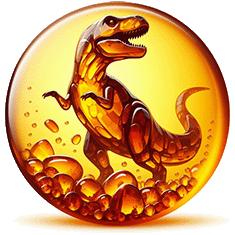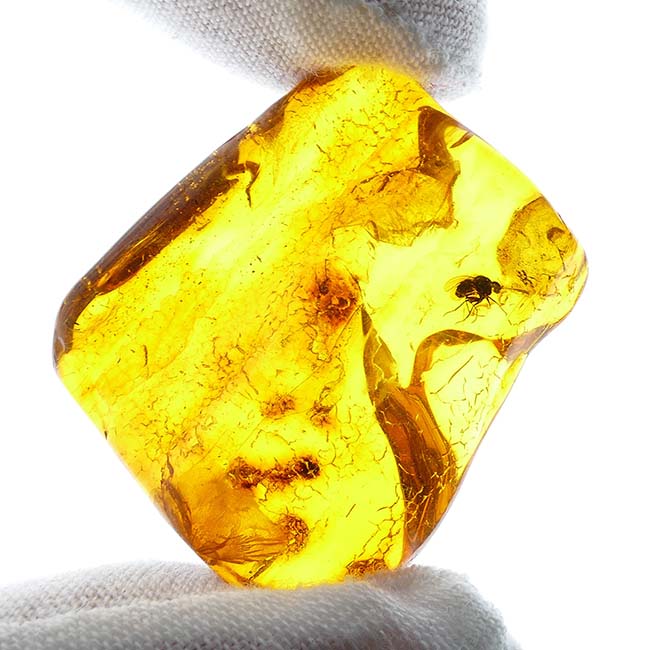
Baltic Amber: Knowledge Base
The Ultimate Guide to Understanding Baltic Amber
Welcome to our Baltic Amber Info page! Our team of experts is dedicated to sharing their knowledge and their passion for Baltic Amber with you. With many years of experience and expertise in the field, our experts are here to provide you with valuable insights, to answer your questions and to guide you through the world of Baltic Amber.
Baltic Amber Guide
Is amber a gemstone or mineral?
Amber is neither a gemstone nor a mineral in the traditional sense. It’s actually hardened tree resin, which is an organic material. Gemstones are usually hard minerals found in rocks, while amber comes from trees.
Where does Baltic amber come from?
Baltic amber comes from the Baltic Sea region, near northern Europe. It washes up on beaches sometimes, but it also comes from underground! These areas were once covered in forests millions of years ago, and the amber formed from the sap of those ancient trees. As the name suggests, Baltic amber is found in the Baltic Sea region, particularly along the coasts of Lithuania, Latvia, Estonia, Poland, Russia, and Germany.
How can you identify real Baltic amber?
Here are a few simple ways to identify real Baltic amber:
- Warmth Test: Real amber feels slightly warm to the touch when rubbed between your fingers. Fake amber (plastic) will usually stay cool.
- Float Test: Fill a glass with saltwater (mix 4 tablespoons of salt with 1 cup of water). Gently drop your amber piece in. Real amber should float, while fake amber will likely sink. (Not always foolproof, some fakes can float too!)
- Visual Inspection: Real amber has a natural, glossy shine and may have tiny bubbles or imperfections inside. Fakes may look too perfect or have an unnatural shine.
Important Note: These are not foolproof methods, and some tests (like the hot needle test) can damage your amber. If you’re unsure, it’s best to consult a jeweler or buy from a reputable source.
What is a sun stone/sun spangle in amber?
Sun stones or sun spangles in amber aren’t actually separate stones trapped inside the amber. They’re tiny cracks or air bubbles that have formed inside the amber. Over time, these cracks have spread out in a circular pattern, catching the light and creating a sparkling golden effect. It’s kind of like a natural fingerprint inside the amber!
What are the believed therapeutic benefits of Baltic amber?
Here’s a simple explanation of the believed therapeutic benefits of Baltic amber:
- Soothing feeling: Some people believe wearing Baltic amber jewelry, especially close to the skin, can bring a calming effect and reduce stress.
- Pain relief: There’s a belief that amber necklaces, worn by children during teething, can help with teething pain.
- Maybe helps your body: Some think amber might boost your immune system, but there isn’t much science to prove this yet.
It’s important to remember these are just beliefs, not proven facts by doctors.
How old is Baltic amber?
Baltic amber is estimated to be between 35 to 50 million years old, dating back to the Eocene epoch.
What makes Baltic amber different from other types of amber?
Baltic amber is like a special kind of amber! Here’s what sets it apart:
- Age: It’s much older than most amber, some pieces being millions of years old!
- Origin: It comes specifically from the Baltic Sea region.
- Color: It often has a warm, rich yellow or honey color, but can also be clear, green, or even reddish.
- Succinic Acid: It contains more succinic acid, which is what some believe gives it special properties.
How long has Baltic amber been used in jewelry making?
Baltic amber has been used in jewelry making for a very long time – thousands of years! People have been finding and using this beautiful material for jewelry since way before recorded history.
Where can I buy authentic Baltic amber jewelry?
Here are a few places you can look for authentic Baltic amber jewelry:
- Jewelry stores: Look for reputable jewelers who specialize in Baltic amber or amber jewelry in general. They may have a certificate of authenticity for their pieces.
- Online retailers: There are many online stores that sell Baltic amber jewelry. Be sure to choose a reputable website with good reviews and a clear return policy. Look for sellers who mention the origin of the amber (Baltic Sea) and offer certificates of authenticity.
- Craft fairs and artisan markets: You might find unique pieces of Baltic amber jewelry from local artisans at craft fairs or farmers markets.
What are some popular designs or styles of Baltic amber jewelry?
Baltic amber jewelry comes in all shapes and sizes, but here are some popular styles:
- Classics: Simple necklaces, bracelets, and earrings with single or multiple amber beads.
- Modern: Geometric shapes, mixed materials (amber with silver or other metals), and clean lines.
- Nature-inspired: Pieces that incorporate organic shapes, leaves, and insects trapped in amber.
- Statement pieces: Bold necklaces, chunky bracelets, and large pendants that showcase the beauty of amber.
- Beaded jewelry: Necklaces, bracelets, and anklets made with smaller amber beads in various colors.
There’s something for everyone!
Can Baltic amber jewelry be worn by people of all ages?
Yes! Baltic amber jewelry can be worn by people of all ages. It comes in many styles, so there’s something for everyone, from babies and children to adults and seniors. Just be sure to choose age-appropriate sizes and designs, especially for young children.
How do I know if the Baltic amber jewelry I’m buying is of high quality?
Here are a few simple tips to see if Baltic amber jewelry is high quality:
- Look: Real Baltic amber has a warm, natural beauty. It should be smooth and clear, with a nice luster (shine).
- Touch: It should feel light and slightly cool to the touch. Not plastic-like.
- Smell: If you gently warm the amber (by rubbing it), it may give off a faint pine tree scent. Fake amber won’t smell like anything or might have a chemical odor.
- Test (optional): You can try the float test in saltwater (real amber usually floats, but not guaranteed). However, this method isn’t always reliable, so it’s best to rely on the look, touch, and smell.
Buying Tip: Look for reputable sellers who specialize in Baltic amber and offer certificates of authenticity if available.
What are some common uses of Baltic amber besides jewelry?
Besides beautiful jewelry, Baltic amber can be used for a few other things! Here are some:
- Decoration: People use polished amber pieces for home decor, like little sculptures or accents.
- Art: Artists can use amber in carvings, paintings, or even furniture pieces.
- Therapeutic purposes (not proven): Some people believe amber can help with things like teething pain, but there’s no science to prove it for sure.
Can Baltic amber jewelry be passed down as heirlooms?
Yes, Baltic amber jewelry can definitely be passed down as heirlooms! It’s a beautiful and natural material that can last for generations with proper care. Think of it like a special treasure that can be enjoyed by your family for many years to come.
What factors affect the value of Baltic amber jewelry?
The price of Baltic amber jewelry depends on a few things:
- The amber itself:
- Rarer colors and larger pieces are generally more valuable.
- Amber with interesting inclusions (like insects trapped inside) can also be worth more.
- The craftsmanship:
- Jewelry that’s well-made and designed with skill tends to cost more.
- The type of jewelry:
- More intricate pieces like necklaces might be pricier than simple beads.
- The amount of amber used:
- Naturally, a piece with more amber will cost more than one with less.
Are there any special considerations when buying Baltic amber jewelry online?
Yes, there are a few things to keep in mind when buying Baltic amber jewelry online:
- Look for reputable sellers: Search for sellers with good reviews and a history of selling genuine amber.
- Ask for certificates: Some sellers offer certificates from gem labs to guarantee authenticity.
- Check descriptions carefully: Look for details about the amber’s origin, size, color, and whether it’s sold individually or as a piece of jewelry.
- Quality photos: Make sure the seller provides clear photos that show the amber’s details.
- Return policy: Choose a seller with a clear return policy in case the amber isn’t what you expected.
What are some common inclusions found in Baltic amber?
Sometimes tiny pieces of things from long ago get trapped in Baltic amber like bugs stuck in tree sap! These trapped surprises are called inclusions. Some of the most common things found inside Baltic amber are:
- Tiny flies and mosquitoes
- Bits of leaves or twigs
- Pieces of spider webs
- Even the occasional ant or beetle
Are there any notable museums dedicated to amber?
Yes! There are some really cool museums around the world dedicated to amber, especially in places near the Baltic Sea where amber is often found. These museums showcase beautiful amber jewelry, interesting pieces of amber with insects trapped inside, and even explain how amber is formed!
Does Baltic amber have healing properties?
There’s limited scientific evidence to support the many therapeutic benefits traditionally attributed to Baltic amber. Some believe it may help with pain relief, stress reduction, or improved immunity, but more research is needed. Baltic amber has been used for many years for various healing purposes, but there isn’t strong scientific proof yet. Some people believe it can help with things like teething pain, stress, or feeling better overall. If you’re considering it for health reasons, talk to a doctor first. But for sure, Baltic amber jewelry is beautiful!
What colors does Baltic amber come in?
Baltic amber comes in a range of colors, including honey, lemon, cognac, cherry, and even greenish hues.
How to store Baltic amber jewelry?
Here’s how to store your Baltic amber jewelry in simple words:
- Keep it cool and dry: Avoid storing your amber jewelry in direct sunlight or hot places. Heat can damage the amber over time.
- Wrap it up: When not wearing it, store your amber jewelry in a soft pouch or cloth to prevent scratches.
- Give it some space: Don’t keep your amber jewelry crammed in with other jewelry pieces. This can cause scratches.
- Be gentle: Take your amber jewelry off when doing activities that could damage it, like cleaning or exercising.
Can Baltic amber break easily?
Baltic amber is a bit delicate, similar to a hardened piece of tree sap. While it can withstand some wear and tear, it’s more prone to cracking or breaking than, say, a metal necklace. If you accidentally drop it or bump it against something hard, there’s a chance it could chip or break. For that reason, it’s a good idea to handle your Baltic amber jewelry with care and store it safely when not wearing it.
Is Baltic amber radioactive?
Baltic amber is a natural treasure that’s been around for a very long time, millions of years in fact! This means it doesn’t contain any radioactive materials. Unlike some things that glow in the dark, Baltic amber is perfectly safe to wear and enjoy without any worries about radiation.
Is Baltic amber hard or soft?
Baltic amber is on the softer side when it comes to jewelry materials. Unlike gemstones that can scratch glass, Baltic amber can be scratched with something harder like a sharp knife or even a fingernail. This softness makes it easy to carve and shape into beautiful jewelry pieces, but also means you’ll want to take a little extra care of it to avoid scratches.
Baltic amber exhibits a relative softness on the Mohs scale of mineral hardness. This industry-standard scale ranks materials from 1 (softest, like talc) to 10 (hardest, like diamond). While beautiful and durable for jewelry, Baltic amber falls between 2 and 3 on the Mohs scale, meaning it can be scratched by harder materials. This characteristic softness allows skilled artisans to carve intricate designs into Baltic amber for unique and stunning jewelry pieces. However, it necessitates proper care to avoid scratches and maintain the amber’s natural beauty.
What kind of jewelry is Baltic amber used for?
Baltic amber is a really popular choice for all sorts of jewelry because it comes in so many beautiful colors and styles. You’ll find it in classic pieces like necklaces and bracelets, perfect for everyday wear. Amber jewelry also comes in bolder options like statement necklaces and chunky bracelets that can add a touch of sophistication to any outfit. Don’t forget about earrings and rings! Amber’s warm colors and smooth texture look great close to the face and on your hands. And for a truly unique touch, there’s even amber jewelry for your hair and ankles, adding a touch of sunshine wherever you go!
What is succinic acid and how does it relate to Baltic amber?
Succinic acid is like a special ingredient found naturally in Baltic amber, kind of like how raisins are in oatmeal! It’s a substance that forms when trees lived millions of years ago. Baltic amber itself is actually hardened tree resin, and succinic acid is a part of that resin.
Is Baltic amber heavy or light?
Baltic amber is surprisingly light! Unlike stones or glass jewelry that can feel heavy, Baltic amber is much lighter because it’s a fossilized resin. This means it was once tree sap that hardened over millions of years. So, when you hold a piece of Baltic amber jewelry, it should feel comfortable and light on your skin.
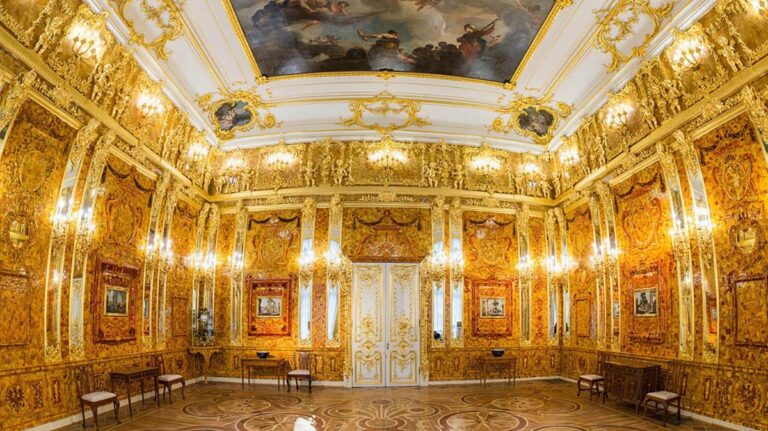
The Amber Room
The Amber Room was an extravagant chamber adorned with amber panels, backed with gold leaf and intricate amber carvings, that was constructed in the early 18th century in Prussia as a gift for Russian Tsar Peter the Great. Considered one of the most valuable and ornate artworks in the world, sometimes called the “Eighth Wonder…
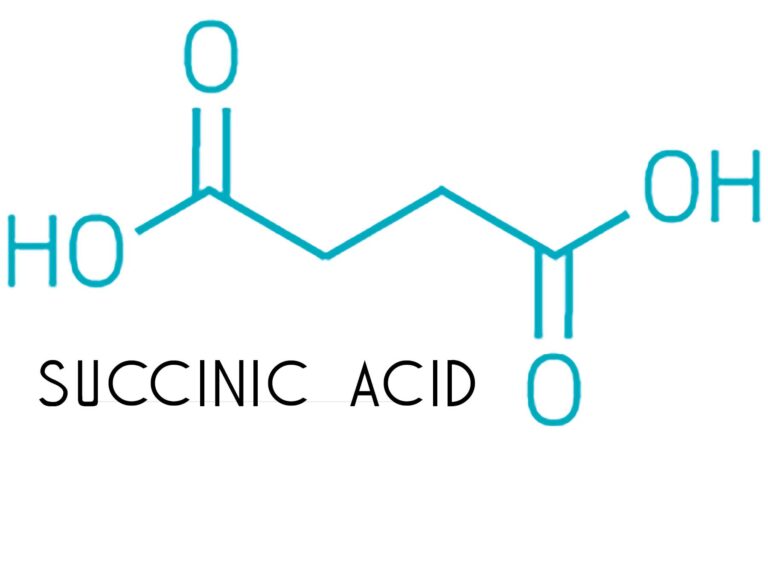
Succinic acid
Succinic acid is an organic compound that is found naturally in amber as well as in some plants and animals. Here are some key points about succinic acid: So in summary, succinic acid is a naturally-occurring compound found in amber that has been used historically for its purported medicinal effects, and is still used as…

What is Baltic amber?
Amber is a fossilized tree resin that has hardened over millions of years. It originates from resin exuded by ancient pine trees to protect themselves by sealing gaps in their bark. This organic substance is renowned for its remarkable ability to preserve intact specimens of prehistoric plants and insects trapped within it. Amber is a…
What is Baltic Amber?
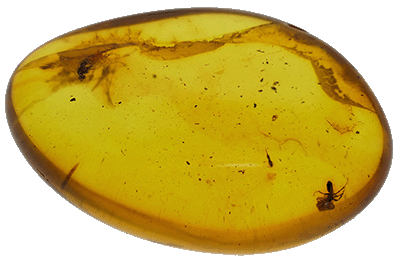
Baltic amber is a variety of amber that comes from the Baltic region, which includes countries like Lithuania, Latvia, Estonia, Poland, and parts of Russia and Denmark. Baltic amber is a beautiful fossilized resin that comes from trees that lived 50 million years ago. Scientists believe this gem formed from the resin of an ancient pine tree species in Northern Europe. These trees produced lots of thick resin during a time of extremely warm climate changes long ago. Amber is a lightweight material, only slightly heavier than water. Its density ranges from 1.04 to 1.10, compared to water’s density of 1.00. This low density allows amber to float easily.
Origin of Amber
Millions of years ago, trees in ancient forests experienced a surge in resin production, although the exact cause remains a mystery. This increase in resin flow may have been triggered by factors like volcanic activity, climate shifts, or tree diseases. As resin oozed down tree bark and collected within damaged trunks, it gradually solidified over time through a slow process called polymerization, becoming the amber we know today. Over the millennia, natural erosion washed these hardened resin deposits into streams and rivers, gradually transporting them to larger water bodies. Today, we discover these ancient treasures preserved in river sediments beneath the Gulf of Gdańsk in the Baltic Sea and along its coastline, as well as in regions affected by ice ages where they were carried by glaciers.
Amber Deposits

The biggest source of Baltic amber is located in Kaliningrad at the Yantarny mine. This mine stores huge amounts of Baltic amber deposits. The amber is dug up from 30 meters (around 100 feet) underground, where it is found in thick, small layers. A lot of Baltic amber is also discovered along the coastlines of the Baltic Sea. Since amber can float on saltwater, many pieces get washed up on the beaches of countries like Poland and Lithuania.
While the Baltic region is the main source, smaller amber deposits can also be found in some other places around the world. These include the Dominican Republic, Myanmar, Lebanon, and Indonesia. However, these deposits are less well-known compared to the major Baltic amber mines.
Amber and Static Electricity
Amber possesses a remarkable ability to become statically charged through friction. In ancient Greece, the term ‘electron’ (ηλεκτρον) was coined specifically for amber, from which our modern word ‘electricity’ originates. Observing that rubbing amber with a woolen cloth caused it to attract pieces of papyrus and feathers, this phenomenon was long regarded as magical. Consequently, it was believed that amber held its own unique essence or spirit.
Succinic Acid
Succinic acid is a natural substance found in living tissues of plants and animals. It is also called “amber acid” because Baltic amber contains a high amount of it on its surface – up to 8%. Baltic amber is the only type of amber that has such a high concentration of succinic acid. Other varieties of amber don’t have nearly as much of this compound. This is why succinic acid is so closely associated with Baltic amber in particular. The presence of high levels of succinic acid in the surface layers of Baltic amber is what makes it unique compared to other amber types.
The Amber Room
The Amber Room was an extravagant chamber adorned with amber panels, backed with gold leaf and intricate amber carvings, that was constructed in the early 18th century in Prussia as a gift for Russian Tsar Peter the Great. Considered one of the most valuable and ornate artworks in the world, sometimes called the “Eighth Wonder of the World,” it contained several tons of amber. The Amber Room met a mysterious fate when it was looted by Nazi forces in 1942 during World War II from its home in the Catherine Palace near St. Petersburg, disassembled, and transported to Königsberg, after which it simply disappeared without a trace, despite many attempts over the decades to locate and reconstruct this tragically lost masterpiece.
Baltic Amber in Middle Ages
During the Middle Ages, Baltic amber’s main exported product was intricately carved prayer beads. From the 16th to 18th centuries, the versatility of this “gold of the Baltic” allowed it to be fashioned into a wide array of goods beyond religious items – including jewelry like bracelets and necklaces, containers and tableware like boxes, bowls and plates, musical instruments like flutes, functional items like buttons and pipe mouthpieces, games like chess sets, timepieces like watch cases, and even lavish interior decor fittings for the wealthy. The major trading centers controlling this flourishing amber industry were located in the cities of Königsberg (modern-day Russia) and Danzig (modern-day Poland).
Amber in Rome
In Rome, during the reign of Nero, Romans travelled to the coast of Germania to purchase amber. One expedition proved so successful that a special “amber day” was arranged, where this costly item was used to decorate the gladiator games. In the protective netting between spectators and the arena, a glittering amber ornament was placed within each knot and the actual arena was apparently strewn with amber! During that time, the southwest coast of the Baltic Sea was the most important supplier. The Romans maintained regular trade connections with northern Europe along the so called “Amber Routes”.
Even earlier, amber was revered by the Phoenicians, who traveled the seaway to what is today the Danish west-coast. Grave-finds from all countries around the Baltic Sea prove that earlier amber was a common trade object to Stone Age man. Since prehistoric times amber has thus been a readily sought after material. Its color, luster, warmth, aroma, electric properties and background, in a scientific sense, place amber in a special category among ornamental stones.
Amber and Magic
In days gone by, amber was acclaimed to possess the power of healing. Worn as a necklace or charm, or carried around in small bags, amber was believed to be a remedy against such ailments as gout, rheumatism, sore throats, toothache and stomach-ache. It was also believed that amber accelerated birth and was a good remedy against snake bites. To guard against the swapping of a new born baby, the infant it was often given an amber necklace to wear. Amber was supposed to contain magical powers, which is why heart shaped amber charms were carried to offer protection against evil forces and help against witchcraft.
Amber Facts
- During the Roman times, higher prices were paid for small amulets in amber than for healthy slaves.
- In 79 AD, Plinius wrote that the women of northern Italy wore amber beads against thyroid.
- Martin Luther carried a piece of amber in his pocket as a protection against kidney stones.
- In ancient China it was customary to burn amber during large festivities. This practice both signified the wealth of the host as well as honoring the guests.
- According to Mohammed, a true believer’s prayer beads should be made of amber.
- The father of healing, Hippocrates, declared amber active against a number of diseases including delirium tremens.
- Over 2500 years ago, Thales of Miletos discovered that when amber was rubbed against cloth, sparks were produced and then the amber attracted husks and small wooden splinters. This force was given the name “electricity” after the Greek word electron which means amber.
Authentic and False Amber
In the display the Amber Museum also explains about how to tell the difference between true, treated and false amber. Amber is often sold heated, melted and pressed or even mixed with or made from synthetic materials.
Most true Baltic amber is milky and pale under the crust. The warm “amber” color occurs first after it has been exposed to oxygen for about a hundred years. To make amber more attractive to the purchases, todays industrial amber jewelry producers are manipulating to get the warm brown-reddish amber color, which often also includes discs, called sunspangles.
The most common method make amber clear is to put the material under pressure and heat in an autoclave together with nitrogen. After this procedure, it is put into an oven to obtain the sunspangles and the cognac color. This heating and treating is made to make amber jewelry more attractive.
Baltic amber occurs naturally in a variety of colors: white, yellow, brown, black, red, green and blue. The most common are honey-colored and milky. A small percentages is bone white, due to microscopic gas bubbles. The clear and translucent amber results from flowing and dripping resin. This kind often shows layers from continuing flow on already dried resin. The black and dirty brown colors are caused by a mix of resin, soil and plant fragments. The most rare have a tone of green or blue caused by gas or inclusions. If the craftsman keeps part of the natural shape, when sanding the raw amber, the crust or inclusions give a natural variety of multicolored tones.
It is possible to melt amber pebbles and press them to bigger lumps. It then becomes harder, and less brilliant when cut. Any color can be added in this procedure. This pressed amber is still considered as natural amber by some producers.
Plastic Copies
Since the bakelite and plastic era began early this century, there has been a number of fake amber qualities in the commercial market. Bakelite necklaces were sold in Europe in the early twenties, when amber was in fashion.
In the markets in Morocco, North and East Africa, as well as in the Middle East and India, amber colored plastic necklaces are very common. They are often sold as antique trade beads. Sometimes they are old, very beautiful, large egg-yolk colored strands, but they are still plastic, and tend to be heavier than amber.
The original, real trade beads, which were distributed from northern Europe around 300 years ago, are very rare to find in the market. It is difficult to see the difference, but if a heated needle is put into the hole of a bead, the smell of burned plastic immediately appears. Baltic amber smells like pine resin.
Even without heating the needle, you can tell the difference. Plastic is elastic, and the needle gets stuck in the material, but true amber is brittle and small pieces will chip off by the pressure.
A scientist from British Museum of Natural History, found a falsification in their collection. A very well preserved fly was described as a palaeontological rarity from the beginning of the 19th century. Someone had divided the piece and carved a concave hole and then put the fly in and covered it with an “amberlike” material before gluing the halves together again.
Since the “Jurassic Park” movie, fortune hunters from all over the world have tried to create attractive plastic-imitations with inclusions, sold as true amber. Sometimes even mammalian hair and feathers are skillfully baked in. They are often carved as a Buddha or other figures, sometimes presented with lumps of the same plastic material with a surface that looks like a natural amber crust. To complete the imitation the faked raw lumps are dipped in oil with a smell of resin.
Copal, Young Resin
Resin has always oozed to protect trees all over the world, and the process is still going on. The older the resin is, the harder. It takes millions of years for the resin to harden to amber. When the resin is younger than one million years, it is called copal, a product traded as raw material for varnish and lacquer before the modem synthetic products were developed.
In New Zealand, copal was mined and exported all over the world in the beginning of the century. Today the industrial remains are shown in museums on the North Island. Among the large pieces in the showcases there are quite a few with perfect lizards and giant spiders enclosed, the result of a kind of melting technique used by the miners. There are almost no inclusions in the New Zealand “Kaurigum”, opposed to the very fossil-rich copal from East Africa and Colombia.
Copal turns sticky and smells like fresh resin if heated. It does not take a good polish and the crust comes back in a few years. It is transparent in a champagne color and very brittle. There are different sources in many places, varying in age from a couple of thousand years to one million years.
Is Amber Forever?
Unfortunately, amber is not forever. Roman beads, 2000 years old, have developed a new thick crust. The Baltic amber jewelry from the last centuries has the fine net of new crust on the surface. It is possible to polish it, but it is very difficult with the faceted kind of jewelry that was common at that time.
Some amber from the Dominican Republic crusts already after 10-20 years. In Museum für Naturkunde in Stuttgart, Germany, their valuable collections of inclusions are preserved in plastic-coating to keep them from the devastating oxygen. Only the amber deep down in geological deposits has “survived” since it oozed from the trees. So, what is found today is only very little of all the resin the trees have produced during millions of years.
“Jurassic Park” Amber
In the wake of the movie “Jurassic Park”, the interest in amber with inclusions has been increasing rapidly. In the movie, scientists extracted DNA from dinosaur blood enclosed in the stomach of mosquitoes in amber. Through cloning, real dinosaurs were created, and the rest of the story you probably already know. Scientists from the British Museum of Natural History, are now after years of testing, questioning if earlier DNA extractions are conterminated. No successful experiments proved so far.
Most amber found today was formed during the Tertiary Age, about 30-50 million years ago, after the dinosaurs were extinct. In a few places such as Lebanon, New Jersey (USA) and Alava (Spain), amber from the age of the dinosaurs (65-220 million years ago) has been found, but in very small amounts.
Realistic Science
What the movie above all contributed to among scientists all over the world was an increased awareness of how extremely well inclusions in amber are preserved. After millions of years they are visible in three dimensions, showing microscopic details clearly. They may even show behavior or “stories” from the bottom of the prehistoric forests.
The prehistoric conifers, (Pinus succinifera), from which Baltic amber originates, were growing in a subtropical climate in what today is northern Europe. Due to its light weight, Baltic amber was an easily transportable material during the formation of bed deposits during the iceages. Much of the amber found today has been relocated several times. Different kinds of amber are found throughout the world. The amber from Dominican Republic and Mexico comes from a leaf tree, which grew in tropical climate.
Amber Exhibitions
After showing our collection of Baltic amber at the Tucson Mineral show, the Amber Museum in Sweden has been invited to exhibit rare specimens at natural history museums all over USA.
In our exhibitions there are many pieces including 40 million year old “frozen stories”. Some contain insects trapped in the sticky resin during their mating act; others show behavior like ants transporting eggs or carrying away trapped prey. Other specimens include insects caught by spiders, sometimes wrapped up in webs, microscopic arthropods on rotting leaves, fungus growing on dead substances, pollen falling out of the anthers of a flower, small mites riding on beetles and many more.
These frozen moments from the floors of the prehistoric forests can teach us much about the fauna and flora at that time. Scientists can compare inclusions in amber with todays similar species and study the development through the ages.
The insects in amber are very much the same as the ones living today. Their evolution began 350-400 million years ago. When trapped, they were in the early Tertiary Age (30-50 million years ago), already similar in appearance to today’s insects. The mammals were beginning to develop during this era, and a few inclusions of mammalian hair are found, as well as some bird feathers and reptile skin pieces. Recently an entrapped lizard in amber was found in Gdansk-area, Poland.
Inclusions in Amber
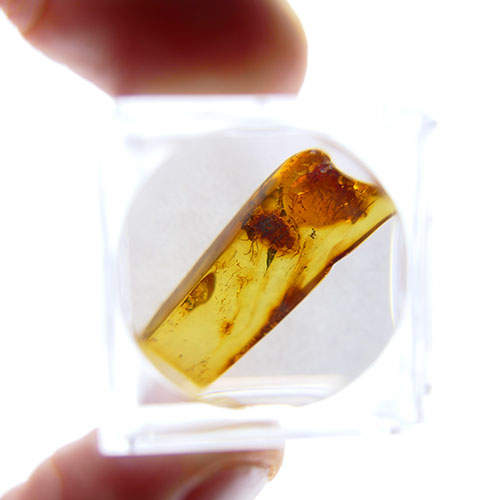
(Plant and Insect Inclusions) The most highly valued pieces of amber contain encased plant matter or organisms, called inclusions. These amber pieces are veritable time capsules, providing us with a glimpse into the past, an opportunity to observe prehistoric flora and fauna.
The majority of inclusions come from the insect family (arthropoda). Most of the creatures found were highly active, living in and on tree bark or on the forest ground. Flies, spiders, centipedes and termites are among the more common inclusions. Vertebrates are rare, but a few amphibians and reptiles, even small mammals have been found.
How did these creatures get inside the amber? After falling into or landing on the sticky resin, the creature was trapped. Any attempt to free itself only made it sink deeper into the resin. Once the dead creature had been completely covered by subsequent resin flows, the process of mummification began until all fluids had left the body. The resulting fossils are preserved in minute detail.
What is visible is the empty casing or shell of the body, while the body cavity itself is usually empty. In rare cases, the internal structure of the inclusion has remained preserved, meaning that the body was completely encased in resin with no fissures exposing it to the detrimental effects of oxygen.
Links: Article about Amber on Wikipedia
Exploring the Geological Origins of Baltic Amber, Healing Properties of Baltic Amber, How to Identify Authentic Baltic Amber, The Intriguing Inclusions Found in Baltic Amber, Formation Process of Baltic Amber, The Science Behind Baltic Amber: Exploring Its Geological Composition, Baltic Amber Jewelry, Raw Amber Jewellery
